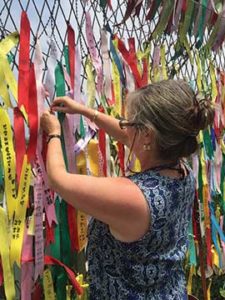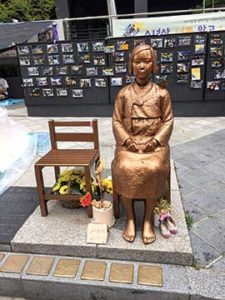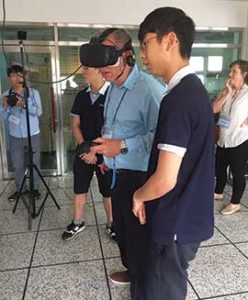Heather Brougham-Cook
When the travel bug bites, it’s hard to shake off the side-effects. I think that bug probably bit me on board the Cape Town Castle, a Union-Castle liner my parents travelled on when they immigrated to South Africa from England. Perhaps it nibbled at a piece of me when I took on the role of second time immigrant and moved my family to the United States from South Africa. Regardless, “wanderlust” is in my blood and I continue to cultivate every opportunity to travel as a teacher.

Travellers experience how different cultures prioritize which values are important, what needs to be preserved and most importantly what is shared with younger generations, making it hard to give up on any opportunity to visit and learn in a new country. My most recent travel opportunity as an educator came from the Korean War Legacy Foundation. I was selected to attend the UN Peace Camp for Teachers in Seoul, South Korea. Co-hosted with the South Korean Ministry of Patriots and Veterans Affairs, the trip always takes place in July and this year coincided with the 65th armistice anniversary celebrations which honour veterans of the Korean War. Most participants in this part of the program are now descendants of war veterans, but this summer I was fortunate to meet many veterans still able to travel and participate in the adventure. That, in itself, was a humbling experience. Faced with unfamiliar language, I was impressed by the kind assistance I received from strangers, as I navigated my way through directions, menus, streets, and transportation like the Seoul Metro. The experience helped me empathize with my students who often face similar challenges when they join new environments and classrooms, where they rely on me as their teacher and on friends for support.
The whirlwind trip, seven days in total, took us to the Korean Demilitarized Zone (DMZ), South Korea’s National Cemetery to view the War Memorial and a unique opportunity to stay overnight at the Jeondeungsa temple, located in Samrangseong Fortress on Gangwha Island. This is a Buddhist temple built by the three sons of Dangun, founder of Korea. The temple played an important role in the 13th century Buddhist revival. Cultural highlights included an evening at Korea House, a theatre in Seoul, to experience “Simcheong”, the most tragic of the five Korean Pansoris (musical storytelling); a visit to the K-Style Hub which exposes visitors to the charm of “hallyu” or the Korean Wave, the increased popularity of Korean entertainment and culture since the 1990s, and a visit to the National Museum of Korea to view some of the priceless national treasures. Visiting and understanding the importance of these destinations reminded me of some of the research tasks I set for my students, which is to discover, research and inform themselves on new ideas and cultures while they read a novel or complete a social studies enquiry. I was “schooled”!

Of course, no visit to a country is complete without experiencing its cuisine and this trip provided ample opportunity to visit superb restaurants and enjoy exposure to Korea’s seasonal cuisine. Food is certainly an area where students tend to be less adventurous, relying on what they know and understand. I pushed outside of my comfort zone to taste everything at least once, before passing judgement. One of the experiences closest to my heart was the visit to Seoul Digitech High School, where we were able to interact with students in classrooms to learn more about how they prosper in a new and growing South Korea. They were super enthusiastic about meeting teachers from the United States, as we were just as thrilled to talk to Korean scholars.
By applying for these specific, teacher-travel opportunities, educators have access to many places and experiences that are not available to a regular tourist. On this trip I experienced our South Korean hosts very willing to discuss ideas on democracy and the rapid growth of the South Korean economy after the war. These conversations may not be as easy to engage in as an average tourist. Knowing we were teachers made many of our hosts more receptive to engaging and exchanging ideas about their beloved country.

I found that being “in situ” produced occasions to interact with locals at a level not typical of a private trip. For example, many educators on the trip were familiar with the Comfort Women memorial statues that dotted around South Korea. While on a bus trip we spontaneously asked to be taken to one of the 50 sites scattered around the country, a request our host obligingly accommodated. The United Nations estimates 200,000 girls and women – mostly Koreans – were seized from villages to join Japan’s military sexual slavery program before and during the Second World War. Being able to view one of these Peace Statues, which is manned 24/7 by volunteers determined to raise consciousness of what happened to these women, was a unique experience, and heightened my awareness of their plight while exposing me to an emotional connection with this narrative in history that I in turn share with the students I teach.
These opportunities are not handed on a platter. Teachers must demonstrate commitment and be able to show how they already incorporate the teaching of Korea in their curricula. Prior to departure, I participated in several hours of professional development in the form of webinars delivered by well-known experts on Korea, all designed to fill background knowledge and broaden my scope of understanding of South Korea before our arrival. Founder and President of the Korean War Veterans Legacy Foundation, Dr Jongwoo Han, an expert on South Korea and dedicated to capturing the memory of Korean War Veterans, proved an invaluable source in the months before we left and during the actual visit. I am forever grateful for his time and irrepressible enthusiasm for his country. Arirang, Arirang, the traditional Korean song, will always be in my heart.
The author is a middle school teacher based in the Lowcountry of South Carolina, USA. She teaches language, arts and social studies to curious 10-12-year-olds. She can be reached at heatherinfive@gmail.com.
